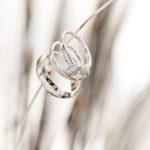When it comes to selecting wedding bands, there are several factors to consider, including whether or not to incorporate diamonds into the design. The significance of wedding bands goes beyond their aesthetic appeal, as they symbolize the eternal bond between two individuals. In this article, we will explore the tradition of incorporating diamonds into wedding bands and the evolution of this practice over time.
The tradition of exchanging wedding bands dates back centuries and has evolved to include various designs and styles. From simple metal bands to intricate designs adorned with precious gemstones, the options for wedding bands are diverse. However, one of the most popular choices is a band with diamonds, adding a touch of elegance and luxury to the symbol of commitment.
Throughout history, the inclusion of diamonds in wedding bands has become a widespread practice, with many couples opting for this timeless and classic choice. The symbolism behind diamonds in a wedding band is significant and carries a deep meaning that transcends its beauty. In the following sections, we will delve into the symbolism of diamonds within the context of a wedding band and explore how personal preference and cost considerations play a role in making this decision.
The Evolution of Wedding Bands
The history of wedding bands dates back centuries, with evidence of similar rings being exchanged by ancient Egyptians as a symbol of everlasting love. However, the tradition of incorporating diamonds into wedding bands is a more recent development. Historically, wedding bands were simple and unadorned, serving as a representation of the unbroken bond between spouses. It wasn’t until the late 19th century that diamonds began to be incorporated into these symbols of commitment.
The Victorian Era and the Rise of Diamond Wedding Bands
During the Victorian era, the trend of using diamonds in jewelry became increasingly popular. This shift was influenced by Queen Victoria’s love for diamonds and her marriage to Prince Albert, which set a precedent for romantic gestures and grand displays of affection. As a result, diamonds began to be included in engagement rings and wedding bands as a symbol of enduring love and commitment.
The De Beers Marketing Campaign
In the 20th century, the De Beers diamond company launched an influential marketing campaign that forever changed the way society viewed diamond jewelry – including wedding bands. The “A Diamond Is Forever” campaign not only solidified the association between diamonds and eternal love but also emphasized the importance of diamonds in celebrating significant milestones such as marriage. As a result, diamond-studded wedding bands became increasingly popular as a way to commemorate weddings and anniversaries.
This historical evolution illustrates how wedding bands have transformed over time, from simple symbolic gestures to precious heirlooms adorned with diamonds. Today, couples have a wide array of options when it comes to choosing their wedding bands, whether they prefer traditional plain bands or opt for the added sparkle and symbolism that comes with diamonds. Ultimately, the evolution of wedding bands reflects not only changes in fashion and trends but also shifting cultural attitudes towards love and commitment.
Types of Wedding Bands
When it comes to selecting a wedding band, there are various styles and designs to consider. From classic and simple bands to more intricate and elaborate designs, the options are endless. Some wedding bands include diamonds, adding a touch of sparkle and elegance to the ring, while others are without any gemstone embellishments.
Styles of Wedding Bands
- Classic: Traditional plain metal bands, such as gold or platinum, with a smooth and polished finish
- Vintage: Designs inspired by different eras, incorporating filigree details or engraved patterns
- Eternity: Bands with diamonds encircling the entire ring, symbolizing eternal love
- Stackable: Thin bands that can be worn individually or stacked with other rings for a layered look
Designs of Wedding Bands
- Solitaire Diamond: Featuring a single prominent diamond as the focal point of the ring
- Pavé Setting: Small diamonds set closely together in the band for a continuous sparkle
- Halo Setting: A center diamond surrounded by a halo of smaller diamonds for added brilliance
- Tension Setting: Diamonds appear to be suspended between the metal ends of the band without prongs or bezel
Whether choosing a wedding band with or without diamonds, there is a vast array of styles and designs to suit individual preferences. From timeless simplicity to dazzling elegance, finding the perfect wedding band involves considering personal style and symbolic meaning. Ultimately, whether opting for classic elegance without diamonds or adding some extra sparkle with diamond accents, the choice reflects one’s unique love story.
The Symbolism of Diamonds
Diamonds have long been associated with love, commitment, and eternity, making them a popular choice for wedding bands. The tradition of incorporating diamonds into wedding bands can be traced back to ancient civilizations, where the precious gemstones were believed to symbolize strength, purity, and an unbreakable bond between two people. In modern times, diamonds continue to hold significant meaning in the context of marriage, representing everlasting love and enduring commitment.
The use of diamonds in wedding bands also signifies the value and importance placed on the relationship between spouses. The durability and resilience of diamonds serve as a metaphor for the strength and steadfastness of a couple’s union.
The brilliance and sparkle of these precious stones are often seen as a reflection of the timeless nature of love and the hope for a bright future together. As such, the presence of diamonds in a wedding band is not merely decorative but carries deep symbolic significance.
In addition to their visual appeal, diamonds are also considered to bring good fortune and positive energy into a marriage. This belief further adds to their desirability as part of a wedding band. Whether set as a solitaire or accented with other gemstones, diamonds play a meaningful role in expressing the depth of emotions shared between partners as they embark on their marital journey together.
| Symbolism | Representation |
|---|---|
| Love | Diamonds symbolize everlasting love |
| Strength | Represents the durable and resilient nature of relationships |
| Fortune | Believed to bring good luck and positive energy into a marriage |
Diamond vs Non-Diamond Wedding Bands
When it comes to choosing a wedding band, one of the key decisions couples face is whether or not to incorporate diamonds into the design. In recent years, there has been a rising trend in opting for diamond-studded wedding bands, adding an extra touch of elegance and sophistication. However, traditional wedding bands without diamonds continue to be a popular choice for many couples.
Traditional wedding bands are typically simple in design, often made from precious metals such as gold, silver, or platinum. These bands focus on the symbolism of unending love and commitment through their circular shape, rather than incorporating elaborate gemstones like diamonds. On the other hand, wedding bands with diamonds feature one or more diamonds set within the band, adding sparkle and luxury to the ring.
While non-diamond wedding bands exude a timeless and classic appeal, diamond-studded bands offer a contemporary and glamorous aesthetic. The decision between these two options often comes down to personal style preferences as well as budget considerations. Couples may also consider factors such as durability and maintenance when deciding between diamond vs non-diamond wedding bands.
| Traditional Wedding Bands | Wedding Bands With Diamonds |
|---|---|
| Simple design | Elegant and sophisticated |
| Focus on symbolism of love and commitment | Add sparkle and luxury |
| Timeless and classic appeal | Contemporary and glamorous aesthetic |
Cost Considerations
When it comes to choosing a wedding band, one of the factors that couples often consider is the cost. The decision of whether to opt for a wedding band with diamonds or without can significantly impact the price. Wedding bands adorned with diamonds tend to be more expensive than their non-diamond counterparts. The presence of diamonds adds a level of elegance and luxury, but it also comes with a higher price tag.
The cost of wedding bands with diamonds can vary depending on factors such as the size, quality, and number of diamonds incorporated into the design. Additionally, the type of metal used for the band itself can also affect the overall cost. For example, platinum bands with diamonds will typically be more expensive than white gold or yellow gold bands with diamonds.
On the other hand, non-diamond wedding bands are generally more affordable in comparison. These bands may feature intricate designs or engravings on the metal, offering a unique and timeless appeal without the added expense of diamonds. Couples who are working within a specific budget may find that opting for a non-diamond wedding band allows them to allocate their resources towards other aspects of their wedding or future plans together.
Ultimately, when considering cost considerations for wedding bands, it’s essential for couples to weigh their preferences and budget constraints. Whether choosing a diamond-studded band or a simpler non-diamond option, finding a ring that symbolizes love and commitment should be the primary focus.
Personal Preference
When it comes to selecting a wedding band, one of the most important considerations is personal preference. Some individuals may prefer a traditional and classic wedding band without any diamonds, while others may desire the added sparkle and elegance that comes with diamond embellishments. Understanding personal preference is crucial in making the right decision when choosing a wedding band.
Symbolism and Meaning
For many individuals, the choice between a wedding band with or without diamonds often comes down to symbolism and meaning. Those who favor tradition and simplicity may opt for a non-diamond wedding band, valuing the timeless significance of the ring itself rather than any additional embellishments. On the other hand, diamonds are often seen as symbols of eternal love, strength, and commitment, making them an appealing choice for those who wish to incorporate these sentiments into their wedding band.
Lifestyle Considerations
Another factor that influences individual preferences when it comes to wedding bands is lifestyle considerations. Individuals with active lifestyles or hands-on jobs may opt for a non-diamond wedding band due to its durability and low maintenance nature. Meanwhile, those who have a more formal or glamorous lifestyle may lean towards diamond-adorned bands for their special occasions and events.
Ultimately, personal preference plays a significant role in deciding whether to choose a wedding band with or without diamonds. Understanding the symbolism behind diamonds, considering lifestyle factors, as well as one’s own taste and style are all important aspects in making this decision. Whether it’s the simplicity of a non-diamond band or the elegance of diamonds, the choice ultimately reflects each individual’s unique relationship and personal values.
Finding the Perfect Wedding Band
In conclusion, the decision of whether or not to have diamonds in a wedding band ultimately comes down to personal preference. While the tradition of incorporating diamonds into wedding bands has become popular over time, it is important to remember that there are no hard and fast rules when it comes to this symbolic piece of jewelry.
Whether one chooses a classic, simple band or opts for the added sparkle of diamonds, what matters most is the significance it holds for the couple.
When considering a wedding band with diamonds, it’s essential to take into account the symbolism behind these precious stones. Diamonds are often associated with enduring love and commitment, making them a meaningful addition to a wedding band. However, non-diamond wedding bands can also hold deep sentimental value and may appeal to those who prefer a more understated look.
Cost considerations are another factor to weigh when deciding between diamond and non-diamond wedding bands. Diamonds can significantly increase the price of a ring, so it’s important to prioritize what is feasible within one’s budget.
Ultimately, the most important aspect of choosing a wedding band is selecting something that resonates with both partners and represents their unique bond. Whether adorned with diamonds or not, the perfect wedding band is one that symbolizes the love and commitment shared between two individuals.
Frequently Asked Questions
Should a Wedding Band Have Diamonds?
Whether or not a wedding band should have diamonds depends entirely on personal preference. Some people prefer the traditional simplicity of a plain metal band, while others may opt for the added sparkle of diamond accents. Ultimately, it comes down to the style and taste of the couple getting married.
What’s the Difference Between a Wedding Band and a Wedding Ring?
The terms “wedding band” and “wedding ring” are often used interchangeably, but they do have slight differences. A wedding ring typically refers to the ring exchanged during the marriage ceremony, while a wedding band usually refers to the ring worn by both partners as a symbol of their commitment. In practice, however, these terms are used interchangeably in many cultures.
Can Wedding Bands Have Gems?
Wedding bands can certainly have gems other than diamonds. Many couples choose to incorporate other precious or semi-precious stones into their bands as a way to add personal significance or meaning. From birthstones to favorite colors, there are endless options for customizing wedding bands with gems beyond just diamonds.

I have been involved in marriages for over 20 years helping couples and singles understand more about them.





